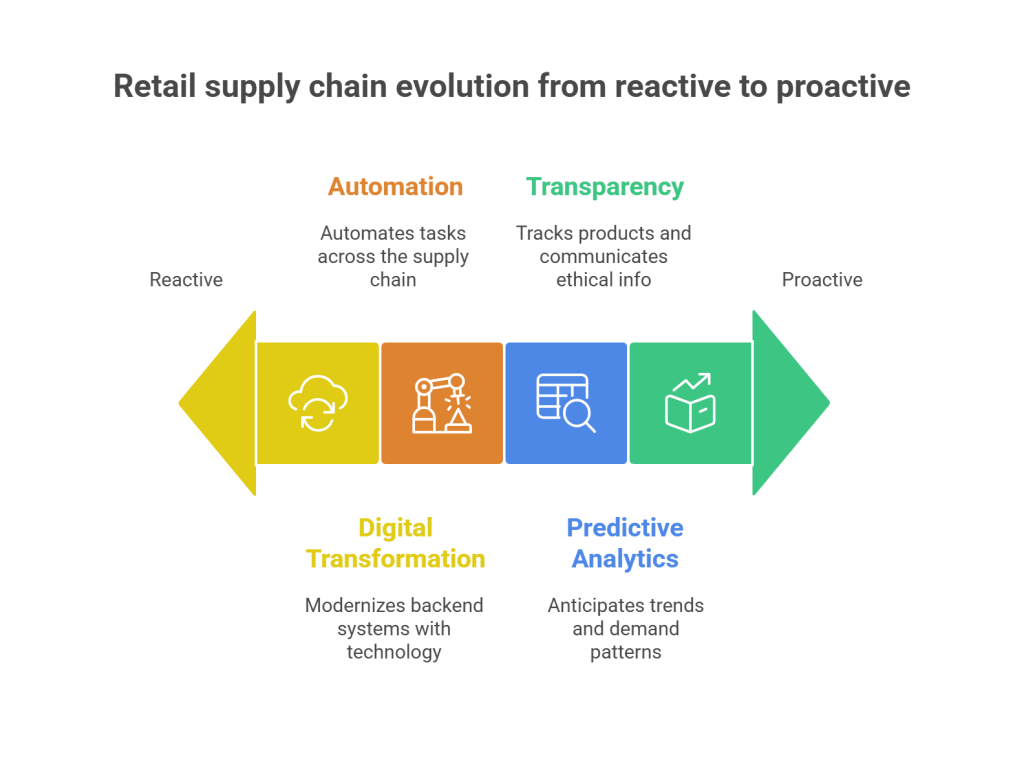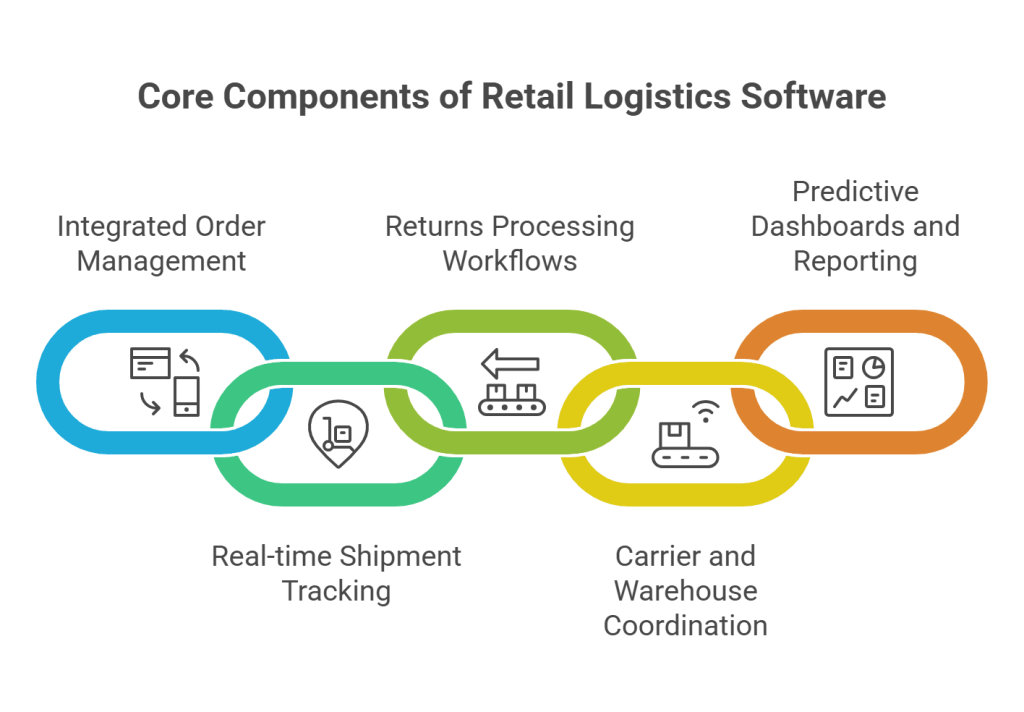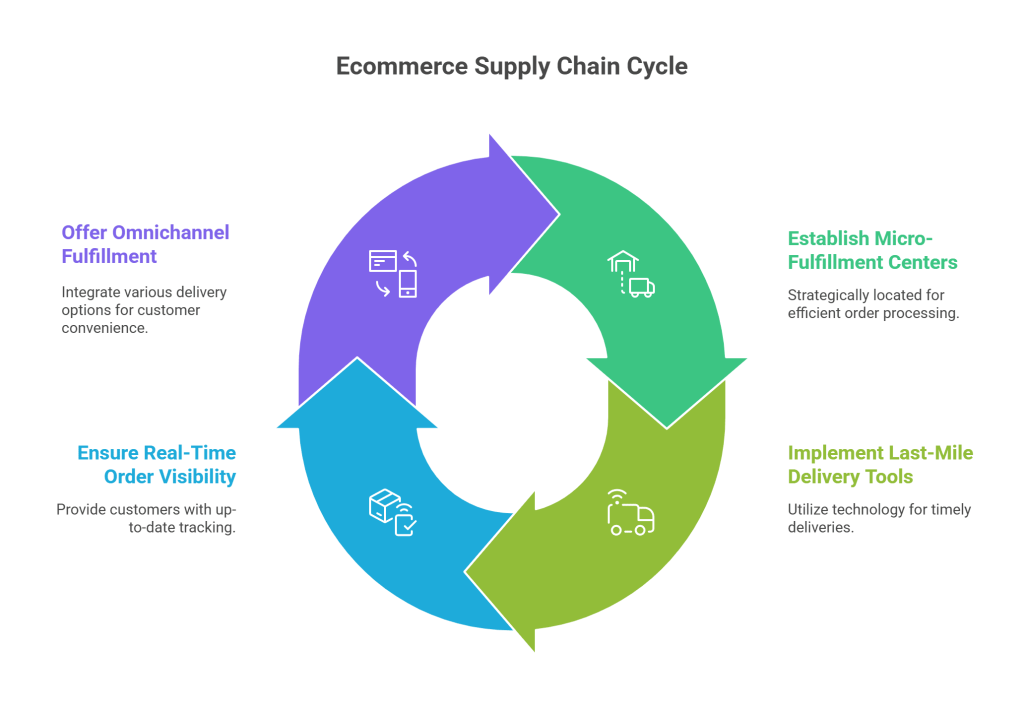In the fast-paced world of retail, nothing stands still for long. One moment you’re fulfilling online orders from a central warehouse, and the next, you’re scrambling to meet same-day delivery expectations from local stores.
What’s behind this growing complexity and speed?

It’s the rapid evolution of retail supply chain systems and the powerful trends that are transforming them from the inside out.
From smart automation to real-time data tracking, retailers are investing big in new technologies to streamline operations, reduce costs, and keep customers happy. But which trends are truly reshaping the game?
Let’s break it down.

1. Supply Chain Digital Transformation is Going Full Throttle
Retailers are no longer just “modernizing” their backend systems – they’re completely reinventing them. Supply chain digital transformation involves using tech like cloud platforms, IoT, and big data to build more connected, intelligent supply chains.
Why is this happening now?
- Online and offline channels are blending into unified commerce.
- Shoppers expect fast, flexible fulfillment.
- Global disruptions (like COVID-19) exposed outdated infrastructure.
Big players like Walmart have embraced this transformation by digitizing their inventory management and transportation systems. Their real-time data visibility across stores and warehouses allows them to respond faster to demand shifts and stockouts.
Benefits of digital transformation:
- Reduced operational silos
- Faster decision-making
- Real-time inventory tracking
- Data-driven planning and forecasting
Now that we understand the importance of digital transformation, let’s explore the growing role of automation.
2. Supply Chain Automation is Making Retail Smarter
Automation is no longer limited to manufacturing floors. Today’s supply chain automation spans everything from order picking robots and driverless forklifts to AI-powered demand forecasting and returns processing.
What are retailers automating?
| Process | Automation Example |
| Warehouse Operations | Automated storage & retrieval systems (ASRS) |
| Inventory Management | RFID & IoT sensors |
| Order Fulfillment | Pick & pack robots, sorting machines |
| Transportation | Route optimization tools |
| Customer Service | Chatbots & self-service kiosks |
Amazon is the poster child for retail automation. With more than 750,000 robots in their fulfillment centers, they’ve cut picking times and enabled one-day delivery at scale.
Why it matters:
- Reduces human error
- Increases throughput
- Enables round-the-clock operations
- Frees up workers for value-added tasks
With automation in place, let’s shift gears to something even more forward-looking: predictive capabilities.
3. Predictive Analytics in Supply Chain is Taking the Guesswork Out
If automation handles the “doing,” predictive analytics handles the “thinking.” Predictive analytics in supply chain enables retailers to anticipate trends, risks, and demand patterns before they hit.
By analyzing past sales, weather data, social trends, and market signals, retailers can make smarter decisions like:
- When to restock specific items
- Which regions need inventory buffers
- How promotions will impact demand
- When disruptions (like port delays) might affect timelines
For example, Target uses predictive modeling to plan store-level inventory for seasonal merchandise. They analyze local trends and historical sales to determine how much Halloween candy to stock in each store—reducing waste and avoiding stockouts.
Key advantages:
- Proactive decision-making
- Better allocation of resources
- Improved forecasting accuracy
- Fewer surprises and emergencies
Now that we’ve seen how predictive insights help stay ahead, let’s talk about the increasing pressure to stay transparent.
4. Supply Chain Transparency is a Business Imperative
Today’s consumers and regulators want to know more about what goes into the products they buy. This has pushed supply chain transparency to the forefront.
What does transparency mean in retail?
- Knowing where raw materials are sourced
- Understanding supplier practices
- Tracking products through the supply chain
- Communicating ethical, environmental info to customers
Unilever has set an example by publishing data about their suppliers and committing to responsible sourcing. They’re using blockchain and digital tracking tools to ensure that ingredients for their personal care brands are ethically and sustainably sourced.
Why retailers are investing in transparency:
- Builds customer trust
- Reduces reputational risk
- Supports sustainability goals
- Helps meet compliance regulations
Now that transparency is on the radar, let’s see how all these changes connect under one roof through retail logistics software.
How Retail Logistics Software is Bringing It All Together

All the trends we’ve explored – automation, data, transparency – need a platform to work seamlessly. That’s where modern retail logistics software comes in.
Today’s software platforms are not just about tracking shipments or managing inventory – they’re comprehensive, AI-driven command centers for retail operations.
Key features include:
- Integrated order management
- Real-time shipment tracking
- Returns processing workflows
- Carrier and warehouse coordination
- Predictive dashboards and reporting
Solutions like Manhattan Associates and Blue Yonder are helping retailers like Kroger and Nike improve fulfillment accuracy and reduce transportation costs using real-time data and machine learning.
With the right software backbone in place, let’s now consider how ecommerce is transforming the supply chain landscape.
The Rise of Ecommerce Supply Chain Management

The explosion of ecommerce has turned traditional supply chains upside down. Instead of shipping in bulk to stores, retailers now ship individual orders to thousands of homes – requiring a different kind of agility and flexibility.
Ecommerce supply chain management involves:
- Micro-fulfillment centers near urban areas
- Advanced last-mile delivery tools
- Real-time order visibility
- Omnichannel fulfillment (BOPIS, curbside, same-day delivery)
Zara adopted a hybrid ecommerce model where stores double as fulfillment hubs. This has helped them shorten delivery times and balance store and online inventory.
Key differences in ecommerce SCM:
| Traditional Supply Chain | Ecommerce Supply Chain |
| Store-first fulfillment | Customer-first fulfillment |
| Bulk shipments | Parcel shipments |
| Static distribution | Dynamic, location-based flows |
Now that ecommerce has created more complexity, let’s explore how AI is helping tame it.
The Growing Role of AI in Retail Supply Chain
Artificial intelligence is rapidly becoming the brain behind modern supply chain systems. From forecasting to fraud detection, AI in retail supply chain enables smarter, faster, and more scalable operations.
How AI is being used:
- Intelligent demand planning
- Autonomous inventory control
- Dynamic pricing based on supply & demand
- AI-driven customer support
- Fraud prevention in payments and returns
Sephora, for instance, uses AI to optimize replenishment at the store level based on factors like weather, events, and foot traffic patterns. This improves both customer satisfaction and stock efficiency.
Why AI is a game-changer:
- Eliminates guesswork
- Adapts to change in real-time
- Helps balance cost, service, and speed
- Improves supply chain risk management
FAQs: 4 Trends Revolutionizing Retail Supply Chain Systems in 2025
1. What’s the biggest challenge in retail supply chain today?
One of the biggest challenges is balancing speed with sustainability. Retailers are under pressure to deliver fast while reducing their carbon footprint.
2. How does blockchain support supply chain transparency?
Blockchain creates immutable records of every transaction or movement, helping verify the origin and journey of products.
3. What is the role of cloud computing in supply chains?
Cloud platforms enable centralized data, collaboration across stakeholders, and faster scaling across geographies.
4. How are small retailers adapting to supply chain digital transformation?
Many small retailers are using SaaS-based retail logistics software that offers modular, pay-as-you-grow capabilities without high upfront investment.
5. What’s the link between AI and supply chain risk management?
AI algorithms can detect anomalies, anticipate disruptions, and suggest alternate sourcing routes, making supply chain risk management more proactive.
6. How is automation transforming warehouse operations in retail?
Automation in retail warehouses—such as robots for picking and packing, automated sorting machines, and smart storage systems—reduces labor costs, increases speed, and minimizes errors, enabling faster order fulfillment and supporting same-day delivery capabilities.
7. What’s the impact of omnichannel fulfillment on supply chain management?
Omnichannel fulfillment requires retailers to seamlessly coordinate inventory and orders across online, in-store, and mobile channels. This increases complexity but offers customers more options (like BOPIS or curbside pickup) and requires accurate, real-time inventory tracking for success.
8. Why is real-time data visibility essential in modern retail supply chains?
Real-time data empowers retailers to instantly spot demand changes, supply disruptions, or delivery delays, allowing for faster, informed decisions that optimize costs, reduce waste, and maintain high service levels.
9. How does micro-fulfillment support ecommerce growth?
Micro-fulfillment centers—small, automated warehouses located close to major customer hubs—enable rapid processing of online orders and lower last-mile delivery costs, making them vital for retailers competing on speed.
10. How are retailers balancing sustainability with rapid delivery expectations?
Retailers are investing in greener delivery fleets, recyclable packaging, and smarter inventory placement to minimize emissions and waste while still meeting customer demands for fast and flexible fulfillment.
Conclusion
Retail supply chains are no longer just about getting goods from point A to point B. They’re about doing it smarter, faster, more transparently, and with less risk.
The trends we discussed – supply chain digital transformation, supply chain automation, predictive analytics in supply chain, supply chain transparency, and AI in retail supply chain, are no longer futuristic ideas. They’re here now, and they’re helping retailers survive and thrive in an unpredictable world.
Whether you’re a global retail giant or a growing ecommerce brand, the message is clear: evolve your supply chain system, or risk being left behind.






